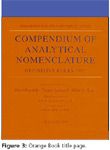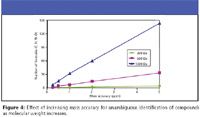Glossaries, Dictionaries, and Understanding Mass Spectrometry
LCGC North America
Definitions, however meticulously crafted, can give the meaning of terms with scrupulous clarity, but often fail to tell us how to apply them. Such definitions are descriptions that dictate usage but stop well short of the sense and purpose that many of us turn to them for.
Definitions, however meticulously crafted, can give the meaning of terms with scrupulous clarity, but often fail to tell us how to apply them. Such definitions are descriptions that dictate usage but stop well short of the sense and purpose that many of us turn to them for.
This year marks the 250th anniversary of what many consider to be the first major contribution to the English language: Samuel Johnson's dictionary (1755). Johnson was contracted by a publisher's group to produce a dictionary in three years, the English equivalent of earlier Italian and French efforts. Reportedly, when reminded that it had taken 40 French academics 40 years to produce theirs, Johnson replied: "Forty times forty is sixteen hundred. As three is to sixteen hundred, so is the proportion of an Englishman to a Frenchman."

Michael P. Balogh
Few nationalities, American included, escaped Dr. Johnson's mordant wit, which even infuses his dictionary. To illustrate proper usage of the term "dull," he writes, "To make dictionaries is dull work." Though Johnson's effort was not the first of its kind, a BBC news article of March 2005 points out, "the quality of definitions, its numerous senses of a term, and the quotations to illustrate usage made it the standard English dictionary for a century and the basis for those that followed" (1). Said to be the second-most quoted source in English, after William Shakespeare, Johnson completed his dictionary in nine years, six years after the original deadline.

Since 1997, I have participated in a mass spectrometry (MS) short course at the Eastern Analytical Symposium (EAS), organized by Dr. Birendra Pramanik of the Schering-Plough Research Institute (Kenilworth, New Jersey). More recently, I have done the same at conferences of the Federation of Analytical Chemistry and Spectroscopy Societies (FACSS). For those presentations, I adopt a strategy similar to the one I use for this column: imparting insights borne of two decades' practice, describing novel instrumentation, and discussing ways to apply solution chemistry to improve practice.

Figure 1: Samuel Johnson. (Courtesy trustees of the Johnson Birthplace, Lichfield, UK.)
Preparing presentation materials invariably proves daunting: reporting on current scientific thought in the briefest of formats with the purpose of providing a take-home practical understanding. Then I must attempt to deliver the material to an audience whose experience ranges from novice to expert to the casually interested. Obviously, I could not do any of this without relying on a language that is common to all scientific efforts.
Over the years, I have annotated my own sources as new terms and phrases evolve — often departing from the original use. It is clear that no single source can suffice. Definitions often are overtly academic. Meticulously crafted, they give the meaning of terms with scrupulous clarity, but they often fail to tell us how to apply them. Such definitions are descriptions that dictate usage but stop well short of the sense and purpose that many of us turn to them for.

Figure 2: Dictionary title page. (Courtesy trustees of the Johnson Birthplace, Lichfield, UK.)
Johnson's dictionary omitted words that begin with "X," as he claimed that "X" begins no English word. With this as my precedent, this month's installment of "MS — The Practical Art" includes my own version of selected items. I also have provided links to some publications that I believe demonstrate proven value.
Methodology for Accurate Mass Measurement of Small Molecules Best Practice Guide
November 2004, Ken Webb, Tony Bristow, Mike Sargent, and Bridget Stein, Department of Trade and Industry's VIMMS Program within the UK National Measurement System.

Figure 3: Orange Book title page.
Although the term "exact mass" is used often, we are more often striving to improve the uncertainty of an accurate mass measurement. The value for increased accurate mass assessment is with analytes well below 1000 Da. Consider the requirements for unambiguous characterization from the Journal of the American Society for Mass Spectrometry author's guidelines (March 2004). For candidate compositions (C0–100, H3–74, O0–4, and N0–4), a nominal mass-to-charge ratio (m/z) response at 118 needs only an error not exceeding 34 ppm to be unambiguous where an m/z response at 750 requires precision better than 0.018 ppm to eliminate "all extraneous possibilities."
In the preface, program manager and editor Mike Sargent describes an emerging dilemma in the practice of MS: "[I]n the past the phrase 'accurate mass' was interpreted very broadly and covered a wide variety of mass spectrometry measurements with varying precision. Today, most instruments used for accurate mass measurements are capable of achieving precisions of 10 ppm or better."

Figure 4: Effect of increasing mass accuracy for unambiguous identification of compounds as molecular weight increases.
A highly diverse and notable 32-member "working group" compiled this 35-page effort that includes specifics for one of the most important aspects of MS practice today. The Methodology includes definitions and comparisons of resolving power, a brief glossary of terms, and references to supporting publications.
A key element in this 2003 "Accurate mass best practice guide" is its development of supporting data, which makes it something more than a theoretical document (2). An interlab study derived data from 49 instruments including quadrupole, time-of-flight (TOF), Fourier-transform MS (FTMS), and magnetic sector instruments. Note that ion traps are not included in this work because accuracy of measurement varies with mass and type of ion and is not usually better than 50 ppm. The list of referenced work itself is one of the best compiled on the topic, and although the glossary is little more than a handful of pages of brief definitions, each entry is coupled with the reference from which it is derived for more extensive study.
Brief, concise, and highly readable explanations — often no more than a few paragraphs — include issues that must be considered when calibrating an instrument (whether external or internal): what to expect for results and the importance of peak shape when attempting to achieve high levels of precision. The discussion also wisely includes related topics such as the role of an electron's mass (0.00055 Da) to determine identity. Rarely would many of us need to consider such a defect in our data, but in the world of high mass accuracy differences in mass can introduce significant error (5.5 ppm at m/z 100).
One overlooked area in MS is the carry-over of concepts derived from technologies and practices developed with the instruments of an earlier era. For instance, the resolving power for a magnetic sector instrument could be determined using the 10% valley method (adjacent peaks of equal intensity). Yet some apply the method to modern quadrupole instruments (using the naturally occurring 13 C isotope as the second peak) rather than the more appropriate full-width at half-maximum (FWHM) method; that is, the peak width at 50% of its height. The result produces a value approximately double that of the 10% valley method (provided that the peaks qualify).
Resolution alone does not determine an instrument's value. So rather than leave the reader suspended, the authors use copious examples to explain the compromise between increasing resolution and precision of measurement.
The Methodology for Accurate Mass Measurement of Small Molecules is easily the best model for future attempts to codify practice.
"Debating Mass Accuracy and Resolution"
Since its rapid growth spurt in the early 1990s, the practice of MS has bifurcated. One branch is high-throughput, driven by various industries, and requires highly sensitive and highly specific instrument response. The other branch of MS practice pursues fundamental studies. Increasingly, the instruments' uses are coming closer together in specification. Instruments we might typically have thought of in the past as qualitative such as ion traps and QTOFs now have extended dynamic range making them more effective quantitation tools while tandem quadrupoles now have ion trapping capabilities.
The most important debate in recent years is spurred by the dominance over the last decade of the hybrid quadrupole TOF technology and the more recent advent of a commercially feasible FTMS capability. As with any analytical instrument, you must understand its underlying technology before you can effectively use the instrument. You must know how to separate and compare performance claims effectively in light of their intended application while remaining within your budget. It will no doubt come as a surprise to some that the low-resolution triple quadrupole is capable of highly refined precision (3). "Debating Mass Accuracy and Resolution," a column that appeared in this space in February 2004, addresses how to effectively separate and compare performance claims in light of their intended application while remaining on-budget (4). This column and others in the 2005 Profiles in Practice series illustrates how these choices were made by experienced practitioners working in different areas.
Mass Spectrometry Desk Reference
O. David Sparkman, Global View Publishing: Pittsburgh, Pennsylvania, 2000.
Anyone who has taken one of Mr. Sparkman's courses knows he is passionate about terminology. So it is hardly surprising that the section on correct and incorrect terms comprises much of this desk reference. Many of the concepts we deal with are elusive, and we tend to use inexact language when discussing them. But in an exact science, we do so at our peril. Here are two examples of commonly misused terms:
- mass spectrum (singular) versus mass spectra (plural);
- mass spectrometry (correct) versus mass spectroscopy (incorrect, because the latter denotes light energy is somehow involved).
The appreciation for precision in language and the discipline to remember when to use protonated molecular ion (incorrect) versus protonated molecule (correct), and positive ion (correct versus) cation (incorrect) is rare. Many consider it an accomplishment if they can break themselves of the habit of referring to EI as "electron impact" rather than the correct "electron ionization," because this is more a phenomenon of physics than a sporting event.
Nor is Sparkman one to shirk his editorial responsibilities. He marks with asterisks terms about which disagreements with the International Union of Pure and Applied Chemistry (IUPAC) or the American Society of Mass Spectrometry (ASMS) conventions arise. He also makes an unrelenting effort to replace gender-specific usage like parent ion, daughter ion, and granddaughter ion with gender-neutral terms such as precursor ion, production, and x-generation production.
The Mass Spectrometry Desk Reference is not without room for improvement (5). One problem where no single effort can do justice is illustrated by use of terms such as "neutral." In today's MS practice, there is much overlap between disciplines and well-established terms will be at odds continually. That is because significant overlap exists between specialty disciplines, and usage of common terms often varies with the specialty. For example, to mass spectrometrists, the term "neutral" means uncharged but to biochemists, who make use of mass spectrometers, "neutral" means underivatized as, for instance, when they discuss the matrix-assisted laser-desorption ionization (MALDI) spectrum of a neutral sugar.
Areas of fundamental importance can escape even the best intentions. The desk reference can get derailed in academic terminology assessments ("amu," versus "a.m.u.," versus "A.M.U.") and, as always in publishing, some editing issues arise. An entry for "molecular mass" defines it differently from one previously provided. What is important is that someone champions the need to create a uniform and descriptive lexicon of mass spectrometric terminology. This is no small task considering that much of the discussion and the terms we use in daily practice evolved in little more than 10 years and it continues to do so in step with our expanding understanding.
The ASMS Mass Spectrometry Terms Project
Kermit Murray, who chairs the ASMS effort, announced at the 2004 annual conference the opportunity for public contribution and comment on mass spectrometry terms. The effort supports work with IUPAC's Analytical Chemistry Division V (6,7). The site is built around a "Wiki" (http://en.wikipedia.org/wiki/Wiki), an on-line user-editable encyclopedia that includes a glossary of MS terms and definitions. The goal is to provide information about, and discussion of, the IUPAC-sponsored project, "Standard definitions of terms relating to mass spectrometry." Interested parties can update the product by accessing www.iupac.org/projects/2003/2003-056-2-500.html. The statistics published at the home site indicate that 548 content pages currently exist. As of this writing, there have been a total of 214,974 page views from 12,558 registered users, and 3175 page-edits since the Wiki was established.
The most recent edition of these terms and definitions can be found in Chapter 12 of the Compendium of Analytical Nomenclature, commonly called the Orange Book. But the Orange Book was created in 1993, its addenda in 1993 and 1994 — the early days of what we now think of as liquid chromatography–MS (LC–MS). The world has changed significantly since then, especially in light of the development of LC–MS practice, which largely has come into existence since that time, fostering technologies, terminologies, and the need for understanding often well ahead of our ability to agree on fundamentals.
Although as an institution IUPAC serves an unquestionably important role, a casual inquiry (as opposed to a scholarly interest) can meet with frustration. The definition for "ion trap mass spectrometry" is a good example: "arrangement in which ions with a desired range of quotients mass/charge are first made to describe stable paths under the effect of a high-frequency electric quadrupole field, and are then separated and presented to a detector by adjusting the field so as to selectively induce path instability according to their reactive mass/charge ratios."
One last reference, which comes close to achieving the desired result for an immediate brief reference document, has been published on occasion in Spectroscopy by Ken Busch (8) and can be found online at www.spectroscopyonline.com. Busch selects each definition and adds the sense and purpose with what might be his own version of Johnsonian flair. Depth and comprehensive coverage are not possible in such a format, something best left to IUPAC.
Clearly there are many other sources of information, but the intent of this column, based upon my years of practice, is to reduce the redundancy and increase the efficiency of your effort. Rather than aspire to achieving an absolute correct answer, it is more often than not enough to avoid being incorrect and to substitute useful assumptions.
Michael P. Balogh "MS — The Practical Art" Editor Michael P. Balogh is principal scientist, LC–MS technology development, at Waters Corp. (Milford, Massachusetts); an adjunct professor and visiting scientist at Roger Williams University (Bristol, Rhode Island); and a member of LCGC's editorial advisory board.
References
(1) The A-Z of Samuel Johnson, http://news.bbc.co.uk/1/hi/magazine/4393709.stm
(2) A.W.T. Bristow and K.S. Webb, J. Amer. Soc. Mass. Spectrom. 14, 1086–1098 (2003).
(3) T. Storm, C. Hartig, T. Reemtsma, and M. Jekel, Anal. Chem. 73, 589–595 (2001).
(4) M.P. Balogh, LCGC 22(2), 118–130 (2004).
(5) W. Boggess, J. Chem. Educ. 78, 168 (2001).
(6) http://www.msterms.com/wiki/index.php?title=Main_Page
(7) http://www.iupac.org/projects/2003/2003-056-2-500.html
(8) K.L. Busch, Spectroscopy 17(2), 54 (2002).

New Method Explored for the Detection of CECs in Crops Irrigated with Contaminated Water
April 30th 2025This new study presents a validated QuEChERS–LC-MS/MS method for detecting eight persistent, mobile, and toxic substances in escarole, tomatoes, and tomato leaves irrigated with contaminated water.
Accelerating Monoclonal Antibody Quality Control: The Role of LC–MS in Upstream Bioprocessing
This study highlights the promising potential of LC–MS as a powerful tool for mAb quality control within the context of upstream processing.
University of Tasmania Researchers Explore Haloacetic Acid Determiniation in Water with capLC–MS
April 29th 2025Haloacetic acid detection has become important when analyzing drinking and swimming pool water. University of Tasmania researchers have begun applying capillary liquid chromatography as a means of detecting these substances.
Prioritizing Non-Target Screening in LC–HRMS Environmental Sample Analysis
April 28th 2025When analyzing samples using liquid chromatography–high-resolution mass spectrometry, there are various ways the processes can be improved. Researchers created new methods for prioritizing these strategies.

.png&w=3840&q=75)

.png&w=3840&q=75)



.png&w=3840&q=75)



.png&w=3840&q=75)












